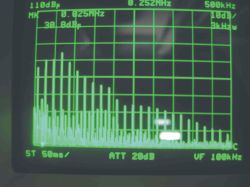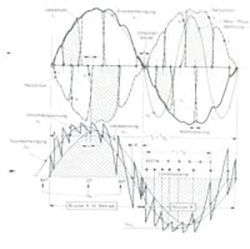EMC problem (switching process)
To reduce and minimize the power loss frequency inverters are working with steep dv / dt switching edges and achieve so far high efficiency. IGBT converters for 400/440V AC operation (560-650V DC link voltage) switch the IGBTs within about <200ns.
This results a voltage gradient to the motor leads of about 3-5 kV per microsecond. A typical low-capacitance motor cable is a common multi-conductor shielded cable with a capacitance of about 200pF/m. The edge steepness causes discharge currents of about 0.6 A/m.
This adds up to for long motor cables to discharge currents up to 20A, which even flow at low power devices and there are significant burden to the inverter.
For long motor cables, the currents do not increase because of the wave propagation (5ns/m). For the installation of frequency converters is important that these currents arise from a very high energy source. If these current are not defined directed, high asymmetrical currents will occur.
If motor cables are connected with contact resistance, for example Connecting the shield as a twisted end (pigtail) or not tighten on the shield, then the discharge currents flow through wires and circuit components such as Control terminals or bus systems and causes massive disturbances.
A safe connection of the motor cable (massive shielding) is essential for good EMC performance of the FC in case dU/ dt and sine filter are not foreseen. Chokes are most essential.
The product standard EN61800-3 for frequency converters specifies limits for emissions.
The EN 55011 -55 022 regulates the conducted interference limits depending on the product and the subsequent use.

EMC problems (harmonic distortion)
A frequency converter simply consists on power grid side of an uncontrolled rectifier and a voltage intermediate circuit with electrolytic capacitors for energy storage.
The power grid (voltage source with low impedance) and the intermediate circuit (voltage source of capacitors) of rectifier diodes are connected to each other. This creates impulsive load currents, which burden the power grid considerably. Regulated by using three-phase line chokes, dv / dt -, or sine filter from Bajog electronic reduces the harmonic distortion, and defused completely depending on the procedure.
The connections of frequency converters direct to the power grid generate a heavy load of the power grid and the medium circuit as well. Harmonic distortion for frequency converters are specified in EN61800-3-2. Interesting is the fact that the existing PFS (Product Family Standard) allow such high interference limits in the lowest frequency range (<150KHz) that third-party devices plugged on the power grid can not possibly work smoothly without interference.

(Bajog electronic)


